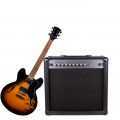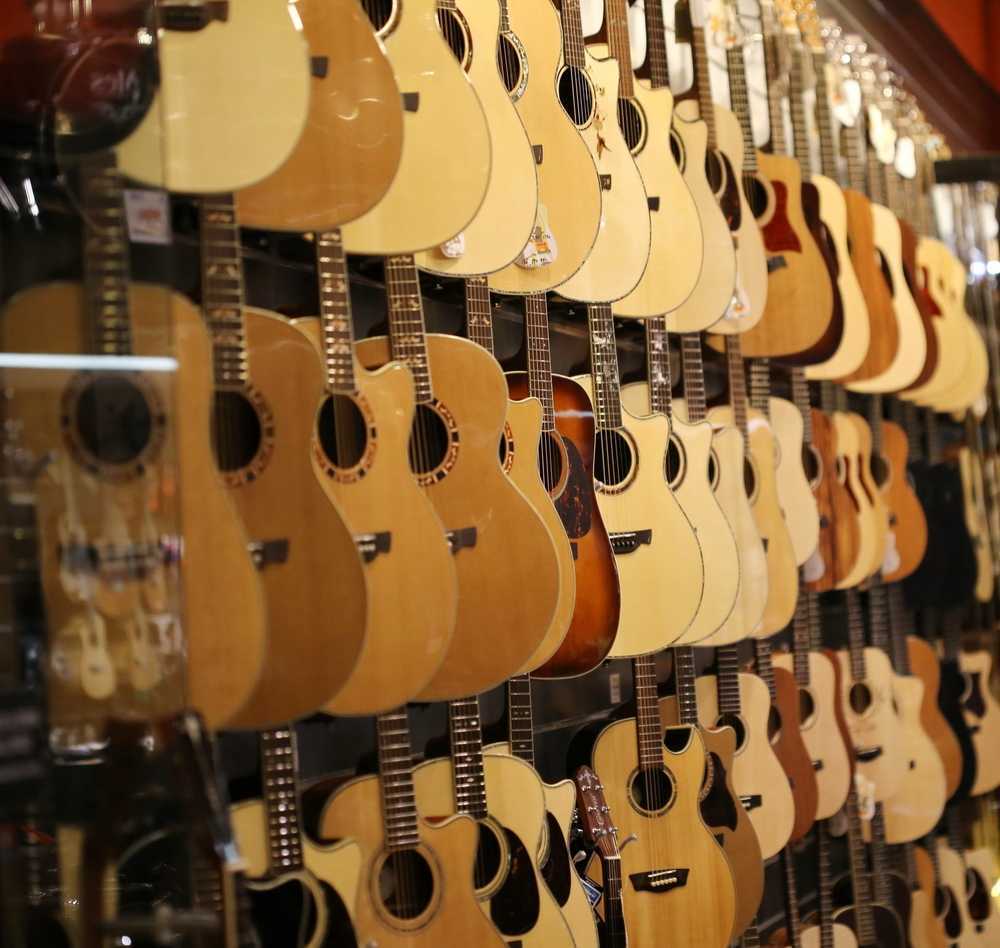There’s nothing that compares to the feeling of getting your first guitar. Whether it’s a gift or one you bought at a music store, owning a new guitar should be a joyful experience filled with endless possibilities and opportunities. No matter how old you are or when you start playing, the music you’ll learn on your first guitar will most likely stay with you for the rest of your life, so your first guitar should be incredibly special. Not surprisingly, most people never think of the un-special aspects of owning a guitar, such as the very important need to invest the time and money into guitar maintenance.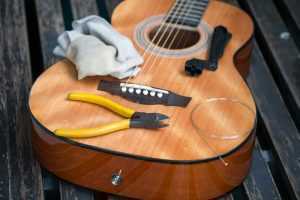
The guitar is a phenomenal instrument that can give a musician a myriad of ways to be creative, original, and thoughtful, but the instrument is more fragile than you might think, and it takes a good deal of work to stay properly tuned and maintained. Surprising factors like the weather and your geographic location can have devastating effects on the health and sound of your instrument, so it’s absolutely paramount that you learn the ins and outs of guitar maintenance before you spend your (or your parent’s) hard-earned cash on a guitar. Remember, the staff at stores like Guitar Center is there to sell you musical equipment, not to make sure your instrument is properly maintained.
Getting familiar with some simple guitar maintenance rules early on will save you loads of stress, money, and even heartbreak later on, so I’m going to walk you through a few simple ways to help you make sure your guitar is safe and in tune.
The Dryness Problem
When I graduated high school, I was flush with cash from relatives and family friends, so I went out and bought a beautiful acoustic Taylor guitar from a local music store. The guitar sounded amazing, and for good reason. Up until I was in my mid-twenties it was the most expensive thing I’d owned. I quickly got to work writing songs and performing at venues with my new beloved instrument. My Taylor acoustic accompanied me to hundreds of shows across the country like a trusty best friend. One unbearably-hot summer day on a downtown Denver rooftop bar, my band played a big show that was sponsored by the local alternative station. As we set up our equipment for sound check, I opened my guitar case to a sight of complete and utter horror: a massive crack extending from the bottom of the guitar up to the sound-hole had somehow materialized on the front of my instrument. I turned the guitar over to find a similar crack on its back as well. How in the world did this happen? I asked myself.
Dryness. If you’ve got an acoustic guitar, dryness should be your sworn enemy. It’s something you need to prepare for and think about. After I mentally recovered from the devastation of seeing my most prized possession get messed up right before a huge show, I went to a music store and had my guitar repaired, but my guitar never looked and sounded the way it did before that summer day on the rooftop. When I bought my guitar, the guy from the music store who sold it to me failed to mention that Colorado’s dry climate is very inhospitable for acoustic guitars, and that I’d need a humidifier, so I had no idea that my guitar was in any danger.
Your acoustic guitar can crack in any sort of climate, but it’s especially at risk in the nation’s dryer climates. Here’s a map to help you see if you live in a dry climate:

If your acoustic guitar normally lives outside of a case next to things like space heaters, wood-burning stoves, dehumidifiers, or in places like hot cars, attics, and rooms filled with direct sunlight, it’s at risk for cracking in any climate. The best way to combat dryness is to purchase a humidifier and to keep it in or near your guitar whenever you’re not playing. All music stores carry small humidifiers that can fit snugly into the sound-hole of your guitar. Humidifiers will add moisture to the air in and around your guitar which will help it not to crack. Remember to add water to your guitar’s humidifier at least once a week, and make sure your humidifier doesn’t drip water onto your guitar. Like dryness, too much moisture has the potential to ruin your instrument.
Take a Stand
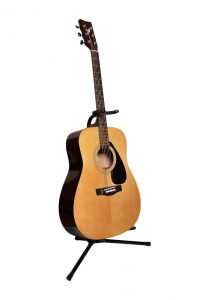
In my decade of guitar teaching experience, I’ve probably saved over 20 guitars that were precariously resting on tables, couches, and walls from falling over and breaking. It seems like a no-brainer, but lots of people forgo buying a guitar stand to save a few bucks and leave their expensive instruments at a greater risk of falling in the process. If you’re practicing guitar and need to leave the room, don’t lean the guitar against the wall or lay it down on the floor. Put it on a guitar stand. Your guitar is special and important, and it should be treated with a great amount of reverence and respect. Keeping your electric or acoustic guitar on a stand is a cheap, common sense guitar maintenance trick that could save you lots of trouble and anguish. It’ll also make your guitar teacher happy and considerably more relaxed.
Just In Case
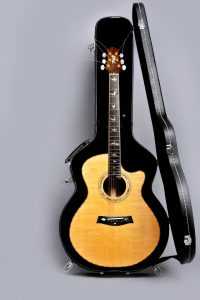
If you aren’t playing your acoustic or electric guitar, it’s absolutely essential that you put it in a case resting in a dry room. I’ve seen so many young students and their parents show up to a guitar lesson with a beautiful new guitar only to find out that they didn’t buy a case. Guitars are incredibly fragile instruments, and they need to be stored in hard or soft cases when they aren’t being played. Stray guitars lying around without cases are at risk of being broken or destroyed by household pets, young children, or clumsy adults.
It doesn’t take much time, energy, or discipline to keep a guitar in its case or on a stand, but lots of people forget to do these common sense things and leave their expensive instruments at risk of getting stepped on or tipped over. Keeping your beloved acoustic or electric guitar in a case or on a stand is more than half the battle in smart guitar maintenance.
Keeping Things In Tune
The guitar is one of music’s greatest instruments, but it’s unplayable if it isn’t in tune. Luckily, with the ever-increasing prevalence of smartphones, it’s now easier than ever to keep your guitar in tune and ready to play. There are many free, high-quality apps that can use your phone’s microphone to detect the pitch of each string to tell you if it’s flat, sharp, or right on tune. Music stores also carry a wide variety of tuners that also include built-in metronomes.
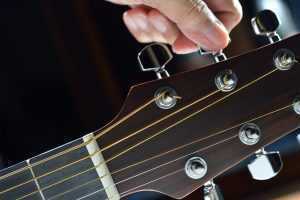
Quick changes in temperature have the power to de-tune your guitar quickly (even in the span of an hour or two in some cases). This is because any sort of shift in pressure has a big effect on the guitar’s strings. If you want to see a good example of this, bring your guitar with you on a flight. When you get off the plane, you’ll find that your guitar strings will be extremely out of tune.
Guitars can also go out of tune when they’re moved, so performing musicians have to tune their instruments very often. Foot pedal tuners are ideal for musicians who perform or tour regularly. Tuners are also great for helping guitarists tune their guitars in unconventional ways. If you want to tune your guitar to D-A-D-G-A-D for instance, a tuner can tell you exactly which way to tune each string. Serious guitarists have tuners.
Get a Clean Sound

When people haven’t played their guitar in a while, they usually say something about their instrument collecting dust in the closet. Like cars, guitars that aren’t played for a long time tend to be susceptible to serious problems that can seriously threaten the health of the instrument. Your guitar should be played at the very least monthly to prevent problems brought on by underplaying.
On the other end of the spectrum, guitars that are played frequently tend to collect grease, oil, dirt, and grime on the fretboard. If you’ve ever seen a guitar caked with grey, sticky sludge, this is what I’m talking about. To clean this off of your guitar, use a soft, dry rag to wipe the sludge off. Some of the gunk might be stuck on there pretty good, so you may need patience and plenty of elbow grease. It may not be the most pleasant part of guitar maintenance, but it is important!
Stringing Right Along
New and seasoned guitar players alike don’t change their strings nearly often enough. Some lofty guitar aficionados will tell you to change out your strings every month, but I think three months is often enough. Since guitar strings are being constantly suspended, they can only sound new and bright so long. Changing your strings often will ensure that your guitar sounds the way it’s supposed to: bright, lush, and full.

Contrary to popular opinion, expensive guitar strings don’t necessarily sound better than cheaper alternatives. If you’re new to learning guitar, try out a few different brands of guitar strings to see what’s right for you. There are different gauges (sizes) of strings out there to accommodate everyone from acoustic fingerpickers to metal heads.
When you change out your guitar strings, make sure to only take off one string at a time. This is a very important guitar maintenance rule. Guitar necks are built to withstand a certain amount of tension, and when all the tension is removed for too long, the neck is at risk for warping. Removing one string at a time will ensure that your guitar’s neck still has enough tension to stay straight.
Great Responsibility
Owning a guitar is awesome, but it takes hard work and responsibility to keep it properly maintained. Smart guitar maintenance is a job that lasts as long as you own your instrument. What do you get for the effort and time you put into maintaining your instrument? A solid, reliable guitar that looks, sounds, and feels exactly how it was meant to!



